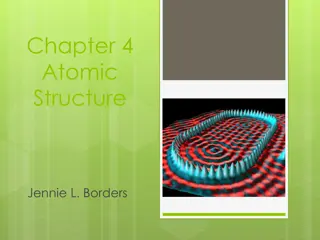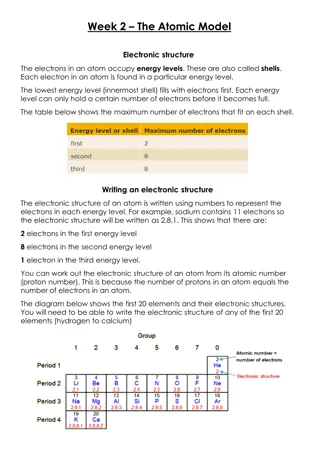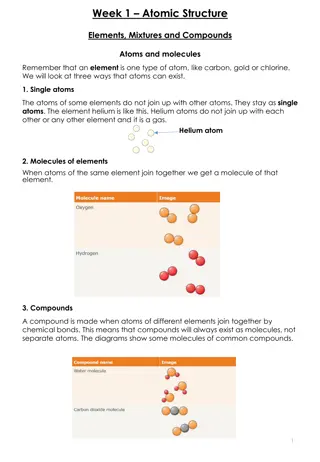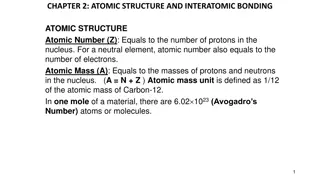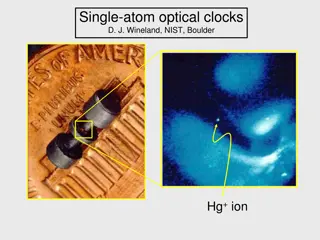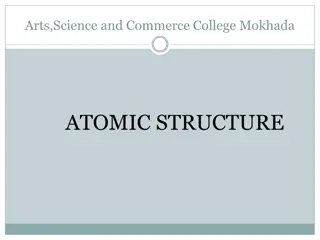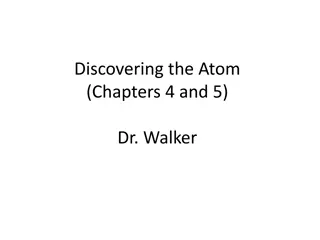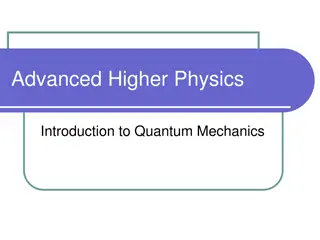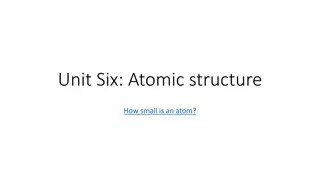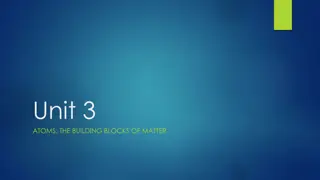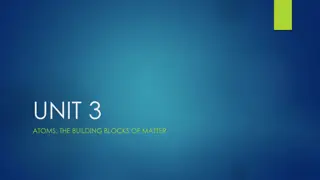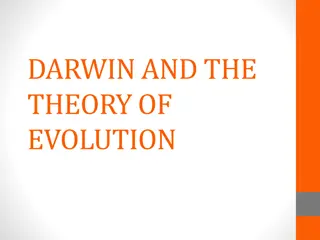Evolution of Atomic Theory Through the Ages
Explore the fascinating journey of the atomic theory from the ancient ideas of Democritus in 450 BC to the groundbreaking discoveries by scientists like Benjamin Franklin, John Dalton, Sir William Crookes, J.J. Thomson, and more. Witness the evolution of our understanding of atoms and their structure, from the indivisible concept of Democritus to Thomson's Plum Pudding Model.
Uploaded on Sep 26, 2024 | 2 Views
Download Presentation

Please find below an Image/Link to download the presentation.
The content on the website is provided AS IS for your information and personal use only. It may not be sold, licensed, or shared on other websites without obtaining consent from the author.If you encounter any issues during the download, it is possible that the publisher has removed the file from their server.
You are allowed to download the files provided on this website for personal or commercial use, subject to the condition that they are used lawfully. All files are the property of their respective owners.
The content on the website is provided AS IS for your information and personal use only. It may not be sold, licensed, or shared on other websites without obtaining consent from the author.
E N D
Presentation Transcript
DO NOW Pick up notes handout Turn in Cha-Cha-Cha-Changes lab. Is your partner s name on it????
The Development of the Atomic Theory Democritus to Rutherford
What do you know about the atom?
450 BC Greek - Democritus Atom was indivisible. Theorized the existence of the atom. Also, theorized that there were just four 'elements' - fire, water, air, earth.
1760 Benjamin Franklin discovers that an object can have an electrical charge. Charge can be positive or negative.
1803 John Dalton 1. Atom was indivisible. 2. All elements are composed of atoms. 3. The same atoms for one element are exactly alike. 4. Atoms are neither created or destroyed in a chemical reaction. 5. In a chemical reaction, atoms are separated, combined, or rearranged. 6. Different atoms combine in simple whole number ratios to form compounds.
1880 Sir William Crookes determined that rays were traveling from one end to another in the cathode ray tube
CATHODE RAY TUBE Others experimented with the cathode ray tube and discovered that the type of gas had no effect so the ray must be a part of all matter. A magnet deflected the ray, so it must be composed of charged particles, and it deflected toward the positive, so the charged particles must be negative.
Late 1890s J. J. Thomson discovered the electron using the cathode ray tube . determined that the electron was smaller than a hydrogen atom. Knew the atom was neutral and the electron was negative, so there must be positive material with a lot more mass.
J. J. THOMSON Said the atom was a positive pudding-like material throughout which negatively charged electrons were scattered - Plum Pudding or Chocolate Chip Cookie Model
1909 Robert Millikan Measured the mass of an electron. Knew the electron was negative, but determined the charge (as a measurement). Was able to use this measurement to determine the mass of an electron. It was 1/1840 of a hydrogen atom.
1909 Ernest Rutherford Did famous gold foil experiment (the alpha scattering experiment). Calculated that the atom was mostly empty space through which electrons move. Concluded that the atom has a small, dense, positively charged, centrally- located nucleus surrounded by negatively charged electrons.
1919 Ernest Rutherford He had refined the concept of the nucleus. Called the positive particles protons.
1932 Ernest Rutherford and James Chadwick showed the nucleus also had neutrons. The neutron was basically equal in mass to the proton but had no electrical charge considered neutral.
1914 Neils Bohr Concluded that the electrons moved around the nucleus in definite orbits or energy levels.
QUANTUMMECHANICAL MODEL - CURRENT Electrons do not move in definite orbits. The exact location of an electron in an atom is impossible to determine. The electron location can only be spoken of in terms of a probability of being in a particular location.
THE DIVISIBLE ATOM Is indivisible . Composes all elements. The same atoms for one element are exactly alike. Atoms are neither created or destroyed in a chemical reaction. Atoms are separated, combined, or rearranged in a chemical reaction in simple whole number ratios. FALSE - divisible TRUE FALSE not alike TRUE TRUE
ATOMIC THEORY to this point is spherically shaped with a dense, centrally located, positive nucleus surrounded by one or more negatively charged electrons in an electron cloud. Most of the atom consists of fast moving electrons traveling through empty space surrounding the nucleus. Electrons are held within the atom by an attraction to the positive nucleus. The nucleus has neutral neutrons and positive protons and 99.9% of the mass. Since atoms are electrically neutral, the number of protons must equal the number of electrons.
THE ATOMIC THEORIES THROUGH TIME
TO DO Handout due Wednesday.



